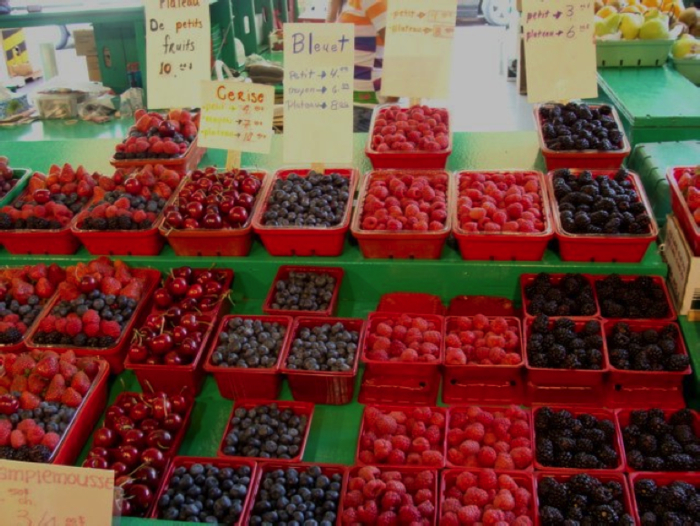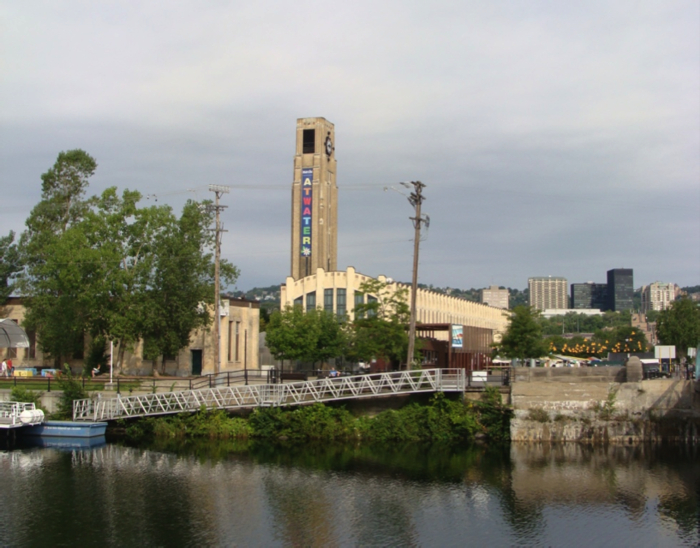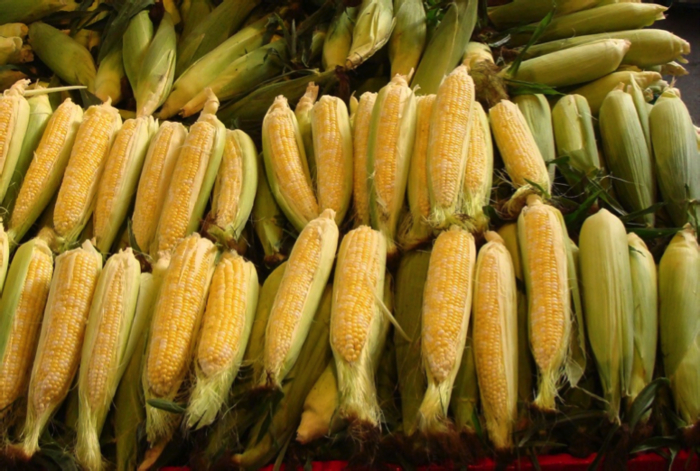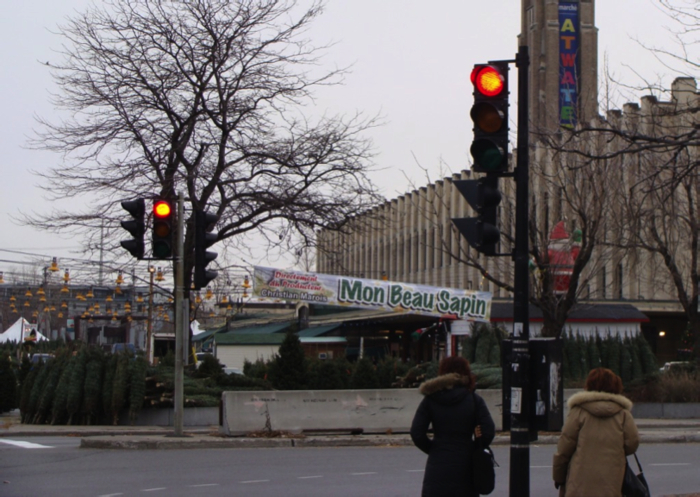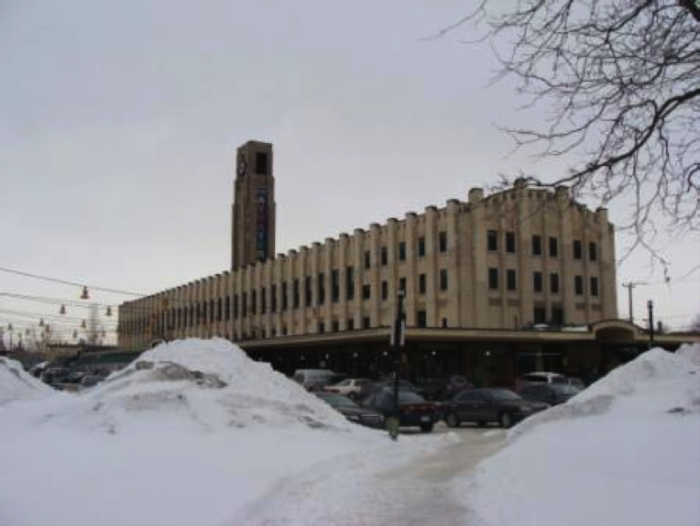Abstracts
Abstract
After a long period of decline, urban farmers’ markets are playing a revitalized role in food distribution in North America as interest in local food increases. Such markets can reveal underlying geographies of cuisine and culture in the surrounding neighbourhoods. Marché Atwater in Montreal, Quebec, was observed over several years in different seasons to study how the space interacted with the surrounding community. Marché Atwater was found to reflect and influence the sense of seasonality in the surrounding neighbourhood of Saint-Henri. The space served as a critical gathering point in a changing urban area and acted as a point of distribution for interesting food practices. A Pecha Kucha photographic presentation is presented to capture elements of the market throughout the year; and Pecha Kucha as a geographic technique is also explored.
Résumé
Après une longue période de déclin et devant l’intérêt grandissant pour les aliments locaux, les marchés agricoles urbains jouent aujourd’hui un rôle de revitalisation dans la distribution alimentaire en Amérique du Nord. De tels marchés peuvent révéler des pratiques culinaires et culturelles sous-jacentes dans les quartiers qui les environnent. Le marché Atwater à Montréal (Québec) a été observé durant plusieurs années et pendant différentes saisons afin d’étudier la manière dont la communauté environnante entre en contact avec cet espace. L’on a constaté que ce marché détient un certain sens de la saisonnalité qu’il impulse dans le quartier environnant de Saint-Henri. Il a également été noté que cet espace sert de point de rassemblement important dans une région urbaine qui se transforme, mais également de point de distribution pour qui s’intéresse à des pratiques alimentaires intéressantes. Une présentation photographique Pecha Kucha a été produite afin de capturer des éléments propres au marché tout au long de l’année ; en plus, c’est en tant que technique géographique que la Pecha Kucha est ici explorée.
Article body
Introduction
An urban farmers’ market is more than a place to buy food. Markets act as a meeting place and as a town square, reinforcing both community and regional identity. Markets have historically retained importance as what Manuel Castells names a “space of flows,”[1] where the daily meeting of culture and nature—that is, the food system—inscribes itself upon the city. The market square and the market hall serve as a centre of the city, a critical infrastructure that allows the coming together of many people.
Markets can thus reveal important aspects of urban culture. As Clifford Geertz notes, “one must find cultural artifacts capable of rendering the curve of social discourse into an inspectable form.”[2] In this study, I hoped to observe the interaction between the marketplace and the surrounding neighbourhood throughout the seasonal year. The market is a rich source of knowledge; it functions as a centre of significant urban activity. Markets are once again shaping urban form in their emergence as what Michel Foucault calls “heterotopic spaces”—spaces where critical reflection and innovation occur outside of the home and workplace. Foucault argues that heterotopic spaces exist as regions between the private sphere and the public sphere, between family space and social space, and between cultural space and useful space, where humanity is nurtured by the hidden presence of the sacred.[3] More recently, such spaces have been called “thirdspaces” by individuals such as Edward Soja of the UCLA Urban Planning Faculty. Thirdspaces are spaces where community is created and defined, and where the city and the population interact through a socio-spatial dialectic. As Soja notes, people are constantly modifying and reshaping places, and places are constantly coping with change and influencing their inhabitants.[4] These spaces are cultural edges, “zones of social interaction, cross-fertilization and synergy.”[5] Marché Atwater, then, considered as a thirdspace, has the potential to reveal shifting cultural and sociological behaviours.
Writing of the evolution of space, Henri Lefebvre describes spaces as living bodies each with their own distinctive traits.[6] Using this model of thinking, a city can be thought of as an evolving ecosystem, filled with areas of growth and decay, shaped by historical events, burned by fire, and abandoned and reclaimed as history unfolds. Understanding these evolving spaces requires more than theoretical discussion; there is a pressing need for accurate and relevant case study observation.
Food as Culture: Canada’s Market Spaces
The study of market spaces in Canada discloses deep cultural truths about Canadian society. It has been noticed that exploring food on the ground level can importantly locate research in place and track how localities are experienced.[7] Further, it is also asserted that food provides a terrain that locates society in cultural space[8] and that part of the creation of geographical knowledge flows through food.[9] I am particularly fond of the idea that food is a liminal substance; it stands as a bridging substance between culture and nature, the human and the natural world, the inside and the outside.[10] In her study of Marché Jean-Talon in Montreal, Quebec, Sarah Musgrave suggests that the market reflects the promotion of place as a marker of authenticity.[11] In a time of rapid globalization, local foodways can form a “bulwark against the unknowns of the global food system.”[12] Musgrave’s work highlights increasing interest in Canadian artisan products.[13]
Canada has joined other Western societies in a general revitalization of market spaces, with both the creation of new markets and the reinvention of existing sites. Year-round enclosed markets play a special role in the Canadian urban landscape: they exist as thirdspaces that are protected from the elements of Canada’s long and harsh winters. I studied Marché Atwater in Montreal over several seasons. The study was conducted using a longitudinal observational methodology: Marché Atwater was visited twice a year in 2008, 2009, and 2010, and once in 2011, to cover all seasons and different times of day and week. The approach I took in the study was a combination of unobtrusive and descriptive observation along the lines described by Norman K. Denzin and Yvonna S. Lincoln.[14] Though other market studies in the larger SSHRC-funded project included interviews and survey methodology, at Marché Atwater, the space was largely allowed to tell its own story. Despite the use of informal interview and grey literature searches to sketch out the history of the market, photos taken of the market space are the centrepiece of this study.
Canadian cuisine as a whole is difficult to define; Canadian culinary heritage is shaped by many complex factors, including region, climate, and cultural variations.[15] Seasonality, however, prominently underlies our culinary rituals and shapes the way we experience both our diets and our neighbourhoods. For example, in Montreal, the long, cold winter has historically limited when certain foods are available and shaped urban cultural practices. In studying the Marché Atwater, I hoped to capture a sense of the seasonality that has survived the globalization of our food systems.
Seasonality, as I use the term, can be understood as the time of year when a particular food is at its peak freshness within a given region. Though global supply chains blur the concept of seasonality, they do not erase it; drawing on research by Anne Colquhoun and Phil Lyon,[16] I therefore understand seasonality within the food system not as the seasonal availability of foods, but as the consumption of foods in the season in which they are traditionally harvested. Collective memory of seasonality remains strong even in an era of global transport. A study conducted by Wilkins et al., for instance, found not only that almost all participants could name local seasonal foods, but also that 78 percent of participants only ate these foods when they were fresh locally.[17] In Quebec, the seasonal rhythm of foods is governed by a short but hot growing season. A comprehensive overview of when foods are in season at Marché Atwater, a playbill of sorts, is available on the Corporation de Gestion des Marchés Publics de Montréal website.[18]
Capturing Seasonality: The Pecha Kucha
A market is not an easy space to capture. Filled with smells, tastes, and sounds, the market can be an elusive subject. A secondary objective of this study was to test the ability of visual images taken in an extended time series to reveal the seasonal cycle of the market. To this end, the market was studied through direct observation supplemented by photography. Direct observation is an appropriate technique to get at “real life in the real world.”[19] The use of photographic observation was pioneered by William Whyte in his work on New York’s public spaces.[20] This study draws upon Whyte’s work, though the actors highlighted are the foods themselves rather than the market’s customers. Future work, beyond the scope of this study, could add to this project through the observation of the groups and individuals who frequent the markets.
To understand seasonality in the market, I used a form known as Pecha Kucha, a presentation format in which 20 images are shown for 20 seconds each. The images forward automatically and the presenter can either narrate or let the images speak for themselves. The format was developed in 2003 by Astrid Klein and Mark Dytham of Klein Dytham Architecture in Tokyo. The format has expanded quickly in popularity, and Pecha Kucha presentation nights now happen in over 230 cities around the world. The format enjoys increasing popularity as a geographical documentation tool, and a short version of the presentation is shown here in the results section.
Several studies have demonstrated the power of the photograph in cultural research. These studies indicate that using photographs and other visual imagery is a powerful tool for understanding and documenting social and cultural life.[21] Sharma and Chapman, for example, had consumers photograph their household food items over time. They suggest that photographs can elicit deeper elements of consciousness than words.[22] We live in a visual culture. Visual methods promote reflexivity, and expand and deepen knowledge production.[23]
Pecha Kucha, in particular, is now the subject of several studies, though only a few are currently in press. Lehtonen argues that Pecha Kucha is suitable for holistic exploration of large-scale concepts and can be used to portray a culture.[24] Klentzin et al. compared Pecha Kucha to conventional powerpoint presentations in a classroom setting and praised the Pecha Kucha’s uniformity and ability to convey information.[25] Given the temporal structure of the technique, I hypothesized that Pecha Kucha would be able to evoke the passage of time. A subset of the photos is highlighted here.
Results: Exploring Atwater
Figure 1
Located in the Saint-Henri neighbourhood of Montreal, along the Lachine Canal, Marché Atwater was built in the 1930s as a make-work project. At the time, urban markets were major infrastructure items, similar to freeways, libraries, or subways. Atwater opened for business in 1933 amid controversy over the scale and cost of the project. Ludger Lemieux designed the building and it is considered to be the finest of his art deco structures, despite the fact that he went severely over budget during its construction. Though the first two floors were designed to house food vendors, and indeed still do, the upper floors contained a hall that could hold ten thousand people standing. This hall would be the site of fierce debates over communism and fascism, union rallies, and stump speeches by prospective Prime Ministers. Outside the market, farmers sold fresh goods from carts.
The neighbourhood occupied by the market, Saint-Henri, is in the South-West of Montreal. Historically, Saint-Henri was an arrival point for Irish and African immigrants. Very much a working-class neighbourhood, it was also known as Les Tanneries (a number of leather tanneries were located along the canal). The canal dominated the area as the main shipping channel between the Atlantic and the interior of Canada. The market was the main site in the neighbourhood for farmers to gather and sell their products[26]. The indoor areas housed butchers, bakers, cheese shops, and other supporting merchants. Atwater market is once again vibrant in the 21st century. I visited the market throughout the seasons and here present a shortened photo collection of my exploration. I include two photos from each season to represent the modern market. While Pecha Kucha can be shown without narrative, it can also be shown with a timed narrative given concurrently; I therefore also include text based on my speaking notes from the presentation.
Spring / Le printemps
Figure 2
Spring in Montreal is a time of planting and renewal. Early in the season, a limited variety of fresh vegetables is available, but the market brims with green. The surrounding communities grow vibrant urban gardens in small backyards and on balconies, and potted greenhouse-sprouted plants are popular to get a head start on the short, hot summer growing season. Preferred plants in the neighbourhood reflect a tradition of home cooking, including very plentiful tomato starts in a number of varieties (especially those suited for tomato sauce). Melons are also a popular choice because they ripen quickly. Cucumbers suitable for pickling are available in large number, and later in the year, they can be seen draping local balconies and fences. The inclination toward preservation reflects the significant role that winter plays in Canadian culture. Early spring is also a time for asparagus, rhubarb, and fiddleheads.
Figure 3
Berries appear at the boundary between spring and summer, with the native blueberry being a popular choice across Canada. Berries are sold fresh in the summer and then preserved for the winter months as jam and jelly. Historically, berries were valued by both First Nations peoples and colonists as an easy-to-preserve source of energy. Dried berries were a staple food through the long winter and were often rehydrated by colonists and baked into pies. Berries do not travel well, and thus remain very popular in local markets and represent a valuable, high-yield crop for small-scale local farmers near the city. When the berries appear, the market grows busier as people hunt for fresh, local produce. Wilkins et al. noted that participants in their studies avoided berries in the off-season, citing poor flavour and texture.[27]
Summer / L’été
Figure 4
The refurbished canal basks in the summer sunlight. As the weather warms, the outdoor spaces around the market become popular gathering places. The outside areas of the market fill with people enjoying the thirdspace, chatting and taking in the sun. Important to note is the fact that the canal fell into disuse after the construction of the St Lawrence Seaway, leading to a decline in industry in the Saint-Henri neighbourhood. The reopened canal, now a historic site and park, is edged with popular biking and walking paths, and the Marché Atwater is a popular stop along the route. The rehabilitation of the canal as a national historic site and the clean up and opening of a bike path along the canal increased property values and led to rapid conversion of old factory spaces to loft housing—a good example of neighbourhood evolution in Canada. Marché Atwater is highly prized by nearby residents and has subsequently evolved from a place where bargains can be found to a more upscale food destination.
In the hot days of August, fresh corn arrives at the market. Best cooked the same day it is picked, corn on the cob is very much a taste found in the Americas. Corn on the cob is a popular barbeque and picnic food, and the bi-colour Peaches and Cream variety is particularly sweet and suitable for roasting or boiling. Fresh corn is a staple of summer meals taken outdoors and a strongly resilient rite of summer across Canada. As Pauline Morel discusses, Canadians find commensality in eating outdoors in the open and in the company of others.[28] Corn is best only for a few weeks of the year and difficult for the home chef to store. Mountains of corn appear at Marché Atwater in the height of summer and then are quickly gone. Other heat-loving vegetables such as tomatoes and peppers appear at the same time.
Figure 5
Autumn / L’automne
Figure 6
In the late autumn, the pace of the market slows, but the surrounding areas burst with a riot of orange pumpkins. The practice of trick or treating for Halloween first emerged in Ireland. When the tradition was brought to North America, the pumpkin served as an improved artistic medium over the traditional rutabaga for Halloween decoration. Beyond pumpkins, the autumn market also boasts a wide variety of apples and pears—some of the last crops to be brought in for the year.
Figure 7
The fall is a busy time for the meat, cheese, and wine vendors in the market; as the days grow shorter and the nights become colder, people tend to prepare heavier and heartier meals. Here, Serge Borduas of Boucherie Claude et Henri shows off his aging room. He ages and butchers meat from scratch, a rarity in the modern supermarket system. Aging develops flavour and tenderizes the meat.
In 1968, Marché Atwater weathered its own autumn when the mayor and city council of Montreal decided to close the remaining six public markets. It was a decade that can only be described as catastrophic for public markets in North America: the council’s attitude that “the large urban market has had its day and is no longer viable”[29] was shared by governments across the continent. The plan to close the Atwater market and convert it into municipal office space, however, lasted only two weeks due to significant public outcry. Other markets were not as lucky: four of the six major urban markets in Montreal were closed in 1968, despite a 1957 study urging the government to keep all Montreal markets open. The hall of the Marché Atwater was partially lost during the 1968 renovations, split into offices.
Atwater survived to blossom in the renaissance of local food, only to be nearly destroyed in December 2002 when fire broke out on the third floor and devastated the top of the building. The market was saved by 150 firefighters from across the city, and has since been rebuilt.
Winter / L’hiver
Figure 8
Although most of the market’s activity moves indoors for the winter, during the holiday season, the market is a popular destination for shoppers looking for Christmas trees. The tree season can provide an important income source for farmers during the long winter. Farmers also sell wreaths and boughs, as well as specialty plants such as holly and mistletoe. Urbanites planning their holiday meals also boost the sales of meat, cheese, and wine in the market, along with the increased consumption of bread and baked goods. The Christmas rush helps to support the market through the long winter.
Figure 9
Preserves are also very popular during the Quebec winter, particularly during the holidays. Along with maple syrup, preserves keep well through the winter months. The specialty jam stall in Marché Atwater features maple products and preserved local fruits and jams, including local specialties such as spiced pears that are much more savoury than the sweet preserved fruits popular in English Canada.
Discussion: Seasons of Cuisine at the Market
Observation of Marché Atwater revealed an ongoing relation with seasonality both in terms of food products and non-edible market products such as seedlings, flowers, pumpkins, and Christmas trees and greenery. The market caters directly to a seasonal flow that remains alive in Montreal despite the ongoing changes brought about by globalization. While some stalls at the market import food from all over the world, farmers and merchants also cater to specifically seasonal needs. It has been noticed that local foodways survive market rationalization because they cultivate a sense of local and regional place while also evoking cultural and spiritual traditions.[30] This seems true in Montreal despite changing demographics and historical neighbourhood transformations. It is surprising how resilient community cultural practice can be. The secular ritual of Halloween, for example, remains an anticipated event even as the neighbourhood changes and shifts.
Marché Atwater also reveals a peculiarity of the Canadian urban landscape as it is used as a thirdspace in a manner that changes with the seasons. Boyer notes that a city’s structure “constantly evolves, being deformed or forgotten, adapted to other purposes, or eradicated by different needs.”[31] Atwater remains a central gathering point; in the summer months, however, activity is focused outward on the courtyard and canal, while in the winter, it is focused inward on the market hall and bakery. As shown below, on the coldest days, the bakery serves as a gathering and a meeting place, despite the Montreal snow.
Figure 10
The use of photography to document the changing seasons of Marché Atwater, and the Pecha Kucha format, allows me to convey a sense of the "motion" of the changing seasons. In particular, the shifting weather and array of foods and produce provides a strong indicator of seasonality within the urban landscape. Comparing different markets from different regions through multiple Pecha Kucha would be an interesting project for a team of geographically dispersed researchers. This format reveals the socio-spatial dialectic noted by Soja[32]: Knox describes this as “People are constantly modifying and reshaping places, and places are constantly coping with change and influencing their inhabitants.”[33] Despite changes to the area, the market remains central. As Whyte notes in his study of New York, “If you want to seed a place with activity, put out food.”[34] The market responds to both rhythms—the long term and the seasonal—and is likely to remain a central hub of culture and social life in Saint-Henri.
Appendices
Biographical note
Lenore is a writer and researcher living in Vancouver and holds a Canada Research Chair in food security and environment at the University of the Fraser Valley in the department of geography. She studies urban food systems, farmers’ markets, Canadian cuisine, and the link between ecosystem health and vibrant food systems; and she is currently working on a compendium of Canadian cuisine highlighting foods under environmental threat, and continues her quest to create the perfect blackberry crisp.
Notes
-
[1]
Manuel Castells, The Castells Reader: Cities and Social Theory, ed. Ida Susser (Oxford: Blackwell Press, 2002): 314
-
[2]
Clifford Geertz, The Interpretation of Cultures (London: Fontana Press, 1993), 19.
-
[3]
Michel Foucault, “Of Other Spaces (1967),” trans. Jay Miskowiec, Foucault.Info, last updated 2012, accessed August 13, 2012, http://foucault.info/documents/heteroTopia/foucault.heteroTopia.en.html.
-
[4]
Edward Soja, Seeking Spatial Justice, (Minneapolis: University of Minnesota Press, 2010): 1.
-
[5]
Nancy J. Turner, Iain J. Davidson-Hunt, and Michael O’Flaherty, “Living on the Edge: Ecological and Cultural Edges as Sources of Diversity for Social-ecological Resilience,” Human Ecology 31.3 (2003): 440.
-
[6]
Henri Lefebvre, The Production of Space (Oxford: Blackwell, 1974), 137.
-
[7]
Lidia Marte, “Foodmaps: Tracing Boundaries of ‘Home’ through Food Relations,” Food and Foodways 15 (2007): 261-89.
-
[8]
Enoch Padolsky, “You Are Where You Eat: Ethnicity, Food, and Cross-cultural Spaces,” Canadian Ethnic Studies 37. 2 (2005): 19-31.
-
[9]
Ian Cook and Philip Crang, “The World on a Plate: Culinary Culture, Displacement, and Geographical Knowledges,” Journal of Material Culture 1.2 (1996): 131-53.
-
[10]
Deborah Lupton, Food, the Body, and the Self (Thousand Oaks, CA: Sage Publishing, 1996), 16.
-
[11]
Sarah Musgrave, “Reading the Real: An Illustrated Tour of Montreal’s Marché Jean-Talon,” CuiZine: The Journal of Canadian Food Cultures 1.1 (2008), accessed August 13, 2012, http://id.erudit.org/iderudit/019374ar.
-
[12]
Amy Trubek, The Taste of Place: A Cultural Journey into Terroir (Berkeley: University of California Press, 2008), 12.
-
[13]
Hersch Jacobs, “Structural Elements in Canadian Cuisine,” CuiZine: The Journal of Canadian Food Cultures 2.1 (2009), accessed August 13, 2012, http://id.erudit.org/iderudit/039510ar.
-
[14]
Norman K. Denzin and Yvonna S. Lincoln, "Introduction: The Discipline and Practice of Qualitative Research", in Norman K. Denzin and Yvonna S. Lincoln, eds., The Sage Handbook of Qualitative Research, 3rd edition (Sage: Thousand Oaks, CA, 2005), pp 1-29.
-
[15]
Dorothy Duncan, Nothing More Comforting: Canada’s Heritage Food (Toronto: Dundurn Group, 2003).
-
[16]
Anne Colquhoun and Phil Lyon, “To Everything There Was a Season: Deconstructing UK Food Availability,” Food Service Technology, 1.2 (2001): 93-102.
-
[17]
Jennifer L. Wilkins, Elizabeth Bowdish, and Jeffery Sobal, “University Student Perceptions of Seasonal and Local Foods,” Journal of Nutrition Education, 32.5 (2000): 261-8.
-
[18]
“Tableau des Arrivages,” Corporation de Gestion des Marchés Publiques de Montréal, accessed August 13, 2012, http://www.marchespublics-mtl.com.
-
[19]
Colin Robson, Real World Research: A Resource for Social Scientists and Practitioner-Researchers, 2nd ed. (Oxford: Blackwell, 2002), 310.
-
[20]
William Hollingsworth Whyte, The Social Life of Small Urban Spaces. Washington, DC: Conservation Foundation, 1980): 50.
-
[21]
Douglas Harper, “What’s New Visually,” in Norman K. Denzin and Yvonna S. Lincoln, eds., The Sage Handbook of Qualitative Research, 3rd ed. (Sage: Thousand Oaks, CA, 2005), pp 717-732: 717.
-
[22]
Sonya Sharma and Gwen Chapman, “Food, Photographs, and Frames: Photo Elicitation in a Canadian Cultural Food Study,” CuiZine: The Journal of Canadian Food Cultures 3.1 (2011).
-
[23]
Elaine Power, “De-Centering the Text: Exploring the Potential for Visual Methods in the Sociology of Foods,” Journal for the Study of Food and Society 6.2 (2003).
-
[24]
Miikaa Lehtonen, “Communicating Competence through Pecha Kucha Presentations,”
-
[]
Journal of Business Communication 48.4 (2011): 464-81.
-
[25]
Jacqueline Courtney Klentzin, Emily Bounds Paladino, Bruce Johnston, and Christopher Devine, “Pecha Kucha: Using ‘Lightning Talk’ in University Instruction,” Reference Services Review 38.1 (2010): 158-167.
-
[26]
Nicole Burisch, "The Atwater Market: Heritage, Tourism, and the Politics of the Public Sphere"
-
[in]
Cynthia I. Hammond and Anja Bock, eds Palimpsest III: The Dialectics of Montreal’s Public Spaces accessed August 28th, 2012, http://cityaspalimpsest.concordia.ca/palimpsest_III_en/papers/Burisch.pdf
-
[27]
Jennifer Wilkins, Elizabeth Bowdish, and Jeffery Sobal, “University Student Perceptions of Seasonal and Local Food,” Journal of Nutrition Education 33.5, (2000), 261-268
-
[28]
Pauline Morel, “Eating Out: The Influence of the Outdoors on Canadian Domestic Foodways” (paper presented at Domestic Foodscapes: Towards Mindful Eating?, Montreal, Quebec, March 21-22, 2008). Cited with permission.
-
[29]
Brian Stewart, “Closing of Atwater Market Confirmed,” Montreal Gazette, September 24, 1968, 3.
-
[30]
Laura B. Delind, “Of Bodies, Place and Culture: Re-situating Local Food,” Journal of Agricultural and Environmental Ethics 19.2 (2006), 121-46.
-
[31]
Christine Boyer, The City of Collective Memory, (Cambridge, MA: MIT Press, 1994), 31.
-
[32]
Edward Soja, Thirdspace: Postmodern Geographies, (London: Verso, 1989): 57.
-
[33]
Paul Knox, "Creating Ordinary Spaces: Slow Cities in a Fast World" Journal of Urban Design, 10.1, 1–11, 2005: 3
-
[34]
William Whyte, Social Life of Small Urban Spaces (Washington DC: Conservation Foundation, 1980): 50.
Appendices
Note biographique
Leonore est une écrivaine et chercheure qui vit à Vancouver et dirige une Chaire de recherche du Canada sur la sécurité alimentaire et l’environnement au département de géographie de l’Université de Fraser Valley. Elle étudie les systèmes urbains d’alimentation, les marchés agricoles, la cuisine canadienne et le lien entre la santé de l’écosystème et les structures alimentaires dynamiques. Elle travaille présentement à un compendium de cuisine canadienne qui fait la lumière sur les aliments menacés par l’environnement et continue sa quête en vue de préparer la parfaite croustade aux mûres.
List of figures
Figure 1
Figure 2
Figure 3
Figure 4
Figure 5
Figure 6
Figure 7
Figure 8
Figure 9
Figure 10





